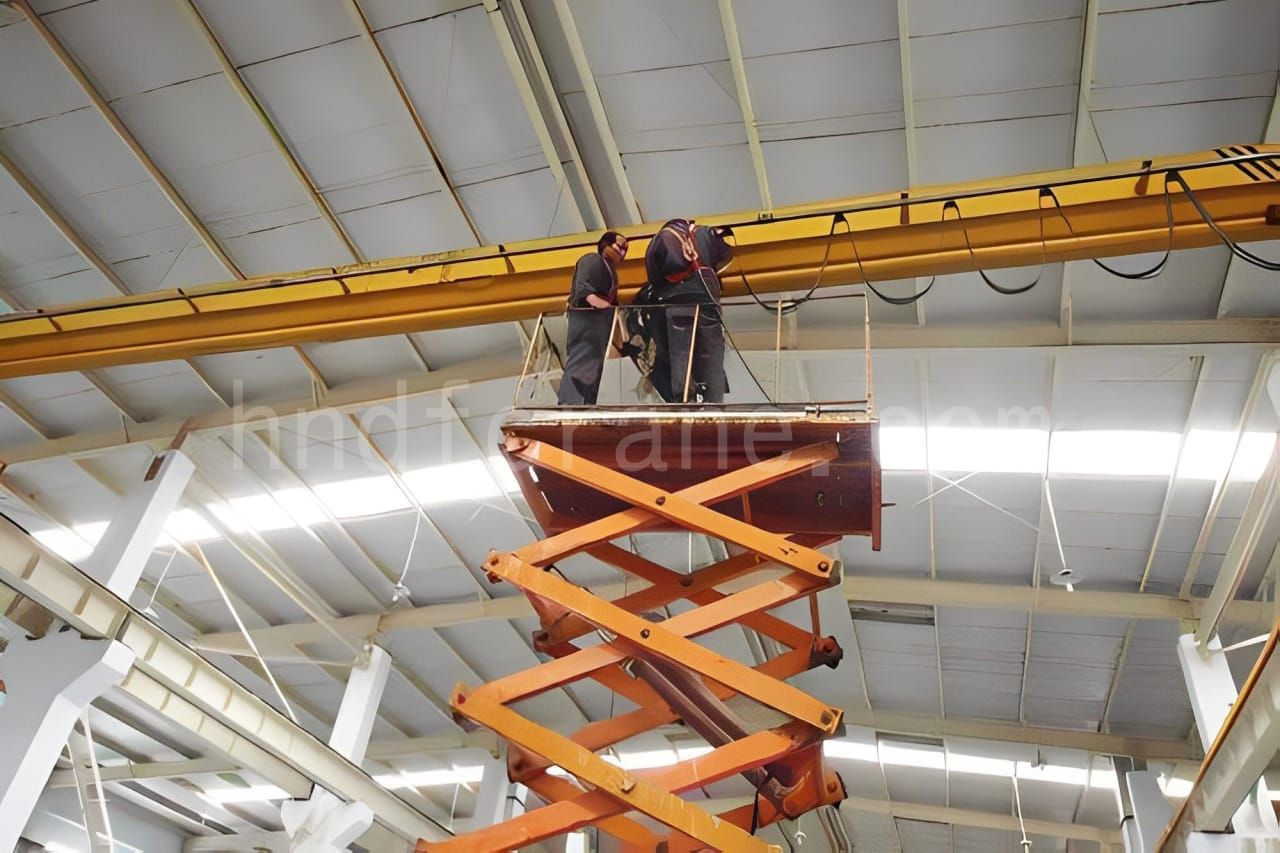Overhead Crane Failures and Repair: Mahahalagang Solusyon para sa Metal Structures at Travel Mechanisms
Talaan ng mga Nilalaman
Ang mga makinarya sa pag-aangat ay hindi maaaring hindi makaranas ng pagtanda at pagkasira habang ginagamit, na humahantong sa iba't ibang mga pagkabigo. Ang artikulong ito ay nagbibigay ng komprehensibong pagsusuri ng mga pagkabigo at pag-aayos sa overhead crane, kabilang ang mga basag at pagpapapangit ng pagkapagod sa istruktura ng metal, pati na rin ang baluktot na paglalakbay at pagngangalit ng riles sa mekanismo ng paglalakbay. Sa pamamagitan ng pag-unawa sa mga pagkabigo na ito at sa kanilang mga solusyon, ang kahusayan sa pagpapanatili at pagiging maaasahan ng overhead crane ay maaaring makabuluhang mapabuti.

Mga Pagkabigo at Pag-aayos ng Overhead Crane Metal Structures
| Mga kabiguan | Mga sanhi | Ayusin |
|---|---|---|
| Nakakapagod na mga bitak sa pangunahing girder web o cover plate | Overload sa mahabang panahon | Para sa mga bitak na mas mababa sa o katumbas ng 0.1 mm, gumamit ng grinding wheel upang pakinisin ang mga ito. Para sa mas malalaking bitak, mag-drill ng mga butas na mas malaki sa Φ 8 mm sa magkabilang dulo ng crack, pagkatapos ay gumawa ng 60° groove sa magkabilang gilid ng crack at magsagawa ng welding repair. Para sa mga kritikal na bahagi na nagdadala ng pagkarga, palakasin ang naayos na lugar na may karagdagang mga plato upang matiyak ang lakas. |
| Parang alon na pagpapapangit sa pangunahing girder web | Overloading, nagiging sanhi ng lokal na kawalang-tatag ng web plate | Gumamit ng flame straightening upang itama ang deformation. Gumamit ng martilyo upang mapawi ang mga panloob na stress. Mahigpit na ipagbawal ang labis na karga sa hinaharap. |
| Baluktot sa gilid ng pangunahing girder | Pinagsamang mga stress sa pagtatrabaho, hindi tamang transportasyon, o imbakan | Gumamit ng flame straightening sa pamamagitan ng pag-init sa matambok na bahagi ng pangunahing girder, at lagyan ng naaangkop na mga jack at mga tool sa paghila kung kinakailangan. |
| Pangunahing girder paglubog pagpapapangit | Structural stress sa pangunahing girder, wave-like deformation ng web plate, overloading, thermal effect, hindi tamang storage o transportasyon, at iba pang salik | Gamitin ang paraan ng prestressing para sa pagwawasto. Pagkatapos ng pagtuwid ng apoy, palakasin ang ibabang takip na plato ng pangunahing girder na may channel na bakal. |
Mga Pagkabigo at Pag-aayos ng Overhead Crane Travel Mechanism
Mekanismo ng Paglalakbay sa Tulay
| Mga kabiguan | Mga sanhi | Ayusin |
|---|---|---|
| Bridge girder skew at pagngangalit ng riles | Labis na pagkakaiba sa diameter sa pagitan ng dalawang gulong ng drive | Sukatin, makina at palitan mga gulong ng crane |
| Ang mga gulong sa pagmamaneho ay hindi ganap na nakikipag-ugnayan sa riles | Balansehin ang mga riles at ayusin ang gulong | |
| Labis na pahalang na paglihis ng gulong | Suriin at alisin ang labis na pahalang na paglihis ng gulong | |
| Pagpapapangit ng istraktura ng metal | Ituwid | |
| Labis na paglihis sa gauge, lateral straightness, at pagkakaiba sa taas sa pagitan ng dalawang riles | Ayusin ang riles at gawing makatugon sa mga teknikal na kinakailangan ang pag-install ng riles | |
| Langis o hamog na nagyelo sa ibabaw ng riles | Alisin ang langis at hamog na nagyelo |
Overhead Crane Trolley Travel Mechanism
| Mga kabiguan | Mga sanhi | Ayusin |
|---|---|---|
| Roil skid | Langis sa riles | Malinis |
| Ang pagkarga ng gulong ay hindi pantay | Ayusin ang pagkarga ng gulong | |
| Masyadong malaki ang pagkakaiba sa taas ng riles sa parehong cross-section | Ayusin ang riles hanggang sa matugunan nito ang mga teknikal na kinakailangan | |
| Magsimula o magpreno nang masyadong marahas | Baguhin ang paraan ng pagsisimula ng motor, piliin ang paikot-ikot na motor | |
| Trolley twists kapag nagsisimula | Hindi pantay na presyon ng gulong o isang pag-angat ng gulong ng drive. Gumagapang ang riles. | Ayusin ang problema na tatlong gulong lamang ang humahawak sa riles. Lutasin ang pagngangalit ng riles. |
Konklusyon
Binabalangkas sa itaas ang mga karaniwang pagkabigo sa overhead crane at mga paraan ng pagkukumpuni sa panahon ng operasyon, tinutugunan ang mga isyu sa parehong mga istrukturang metal at mga mekanismo ng paglalakbay. Sa pamamagitan ng pagsusuri sa mga sanhi ng mga pagkabigo na ito at pagbibigay ng mga praktikal na solusyon sa pagkukumpuni, ang gabay na ito ay naglalayong pahusayin ang iyong pang-unawa sa epektibong pagpapanatili at pag-troubleshoot ng kagamitan, tinitiyak ang mas ligtas na operasyon, pinababang downtime, pinahusay na produktibo, pinahabang buhay ng kagamitan, at pagtitipid sa gastos para sa mga pasilidad na pang-industriya.
Mga Kaugnay na Blog
Critical Overhead Crane Electrical Maintenance and Inspection Guide
Ipadala ang Iyong Pagtatanong
- Email: sales@hndfcrane.com
- WhatsApp: +86-191 3738 6654
- Tel: +86-373-581 8299
- Fax: +86-373-215 7000
- Idagdag: Changnao Industrial District, Xinxiang City, Henan Province, China








































































